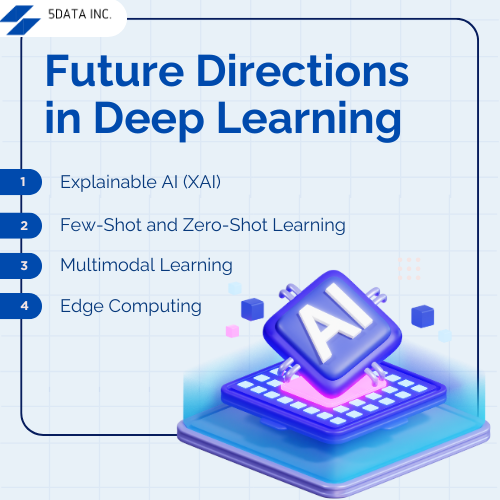Deep Learning in Natural Language Processing (NLP)
In the artificial intelligence era, natural language processing (NLP) facilitates the interaction between computers and human language, with the goal of empowering machines to comprehend linguistic patterns and interpret and understand human language. By incorporating deep learning, NLP has achieved substantial improvements in language understanding and machine language translation.
Key Deep Learning Techniques in NLP
- Recurrent Neural Networks (RNNs): RNNs are tailored for processing sequential data, rendering them well-suited for endeavors such as language modeling and machine translation. They maintain temporal dependencies, allowing them to understand context in sequences of written or spoken text.
- Long Short-Term Memory Networks (LSTMs): LSTMs address the vanishing gradient problem in RNNs, capturing long-term dependencies in text. They are effective in tasks like text generation.
- Transformers: Transformers are the foundation of large language models like BERT, GPT-3, and T5, excelling in a wide range of NLP tasks. They rely on self-attention mechanisms to capture relationships between words in a sentence, enabling parallel processing of sequences and handling long-range dependencies effectively.
- Bidirectional Encoder Representations from Transformers (BERT): BERT is used for tasks that benefit from understanding the context from both directions, such as question answering and sentiment analysis. It processes text bidirectionally by considering both the left and right context simultaneously, improving understanding of the text.
- Generative Pre-trained Transformers (GPT): GPT models are used for text generation, language modeling, and conversational AI. They are pre-trained on a large corpus of text and fine-tuned for specific tasks, using a unidirectional approach to predict the next word in a sequence.
Applications of Deep Learning in NLP
- Speech Recognition: Deep learning models aid speech processing by transcribing spoken languages into text and virtual assistants to understand user inputs.
- Machine Translation: Systems like Google Translate use deep learning to translate text between multiple languages with high accuracy.
- Text Classification: Deep learning models categorize text into predefined categories, aiding in spam detection, sentiment analysis, and topic classification.
- Language Modeling: These models predict the subsequent word in a sequence, producing contextually relevant and coherent text, thereby improving applications such as chatbots and content generation.
Deep Learning in Image Recognition
Image recognition entails the identification and classification of objects, patterns, and features depicted in images. ML has revolutionized image recognition by automating feature extraction and achieving high accuracy in tasks like facial recognition, processing, and medical image analysis.
Key Deep Learning in Image Recognition
- Convolutional Neural Networks (CNNs): CNNs are the cornerstone of image recognition, consisting of multiple layers that detect features and classify images. Convolutional layers detect patterns, pooling layers reduce dimensionality, and fully connected layers perform classification.
- Deep Neural Networks (DNNs): Comprising multiple hidden layers, DNNs learn complex representations and patterns from visual data. They enhance the performance of image recognition systems.
- Transfer Learning: Pre-trained CNN models like VGG and ResNet are fine-tuned on specific visual recognition tasks. This approach leverages previously learned features to improve accuracy and efficiency.
Applications of Deep Learning in Image Recognition
- Medical Imaging: Deep learning plays an important role in diagnosing diseases by analyzing medical images like X-rays, MRIs, and CT scans. It identifies anomalies with high precision.
- Autonomous Vehicles: Image recognition systems detect and classify road signs, pedestrians, and other vehicles. They contribute to the safety and functionality of self-driving cars.
- Facial Recognition: Machine learning is used in security systems and social media to identify individuals based on facial features. Applications include identity verification and tagging.
- Retail and E-commerce: Image recognition helps in visual search and recommendation systems. It enables customers to browse for products using images, thereby enriching their shopping journey.
- Agriculture: Analyzing aerial images from drones, deep learning models assess crop health, monitor livestock, and detect pests. They aid in precision farming.
Integrating Deep Learning in NLP and Image Recognition
- Data Preparation: Effective model development heavily relies on the quality and quantity of training data. In NLP, textual data undergoes cleaning, tokenization, and conversion into numerical formats, while in image recognition, preprocessing, augmentation, and normalization are applied to images. Data Collection And Data Management Service Providers provide holistic solutions for efficiently gathering and structuring vast amounts of data.
- Model Architecture: Selecting the appropriate neural network architecture is vital. RNNs, LSTMs, and transformers are popular for NLP. CNNs dominate image recognition tasks.
- Training and Optimization: During training, models utilize large datasets and backpropagation to refine weights and minimize errors. Hyperparameter tuning and regularization techniques are employed to enhance performance.
Challenges and Solutions
- Data Requirements: Exploring Deep learning necessitates extensive labeled data for training. Techniques like data augmentation and synthetic data generation help mitigate this challenge.
- Computational Resources: Training machine learning is computationally intensive. Advances in hardware (e.g., GPUs, TPUs) and optimization algorithms are essential for efficient training.
- Interpretability: Comprehending how ML models make decisions presents a challenge. Developing explainable AI (XAI) techniques, such as attention mechanisms and saliency maps, helps improve transparency.
- Ethical Considerations: Addressing biases in data and ensuring fairness in model predictions is critical. Ethical AI frameworks and guidelines are necessary for responsible deployment.

Future Directions in Deep Learning
Exploration of deep learning and machine learning in NLP and visual recognition is poised for further advancements, driven by:
- Explainable AI (XAI): Developing models that provide transparent and interpretable decisions crucial for sensitive applications like healthcare and finance.
- Few-Shot and Zero-Shot Learning: Training models with minimal labeled data or recognizing unseen objects, expanding the applicability of deep learning.
- Multimodal Learning: Integrating multiple data types (e.g., text, images, audio) to create more robust and versatile models.
- Edge Computing: Deploying models on edge devices (e.g., smartphones, IoT devices) to reduce latency and enhance privacy.
5DataInc specializes in advanced technology, providing Data Life Cycle Management Services, ensuring seamless organization and maintenance of data throughout its lifecycle.
Conclusion
Deep learning excels in achieving highly accurate outcomes across diverse application domains utilizing sophisticated deep neural network architectures and training techniques. As ongoing research and innovation persist in propelling advancements in artificial neural networks, the trajectory of machine learning holds the potential for further breakthroughs. These advancements are poised to tackle existing challenges while ushering in novel possibilities in the realm of artificial intelligence.
Frequently Asked Questions
1. Are the deep learning algorithms, methods, and artificial intelligence (AI) synonymous?
Deep learning is a subfield of AI concerned with training artificial intelligent virtual assistants to recognize patterns and learn from data. AI is a broader field encompassing various approaches to creating intelligent machines.
2. Does deep learning require a large language model with a lot of data?
Yes, deep learning methods typically require vast amounts of data to learn complex features and train effectively. The more data a model is exposed to, the better it can learn complex patterns and achieve higher accuracy.
3. Can deep learning models be biased?
Deep learning can reflect the biases present in the data on which they are trained. Neural networks must have statistical methods to ensure data is diverse and representative to mitigate bias in the resulting model.
4. How is Transfer Learning Applied in NLP and Image Recognition?
It involves using pre-trained models on new tasks. In NLP, models like BERT and GPT are fine-tuned on specific datasets. In image recognition, pre-trained CNNs like VGG and ResNet are adapted to new tasks, leveraging previously learned features to improve performance.

